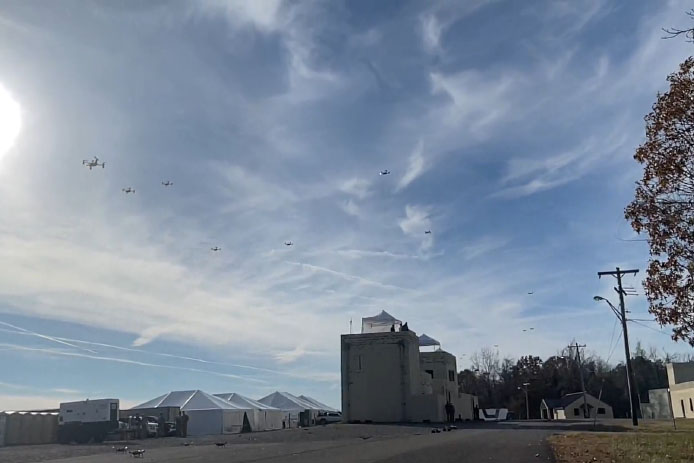
New Delhi: Raytheon Technologies Corporation, one of the largest aerospace, intelligence services providers, and defence manufacturers in the world which develops and manufactures advanced technology products in the aerospace and defence industry, is working on US Navy’s Distributed Maritime Operations.
This involves a network of sensors, riding aboard everything from drones and jets to ships and missiles dispersed across the globe, all taking in data and feeding it back to the fleet to help operators meet a mission anywhere.
The company which has four subsidiaries: Collins Aerospace, Pratt and Whitney, Raytheon Intelligence and Space and Raytheon Missiles and Defence is combining new engineering methods with decades of experience to help bring the initiative to life.
As Vice President of Naval Power at Raytheon Missiles and Defence, Kim Ernzen, said Distributed Maritime Operations is important, and the company is looking at how the business can help the Navy realize its vision.
Ernzen said it will allow the Navy to distribute assets, for instance, with a sensor forward that’s doing passive activity, while an effector is back farther projecting critical infrastructure in a receive mode. This war fighting concept increases capability to achieve the desired effect.
Ernzen’s team provides the US and its global allies in the maritime domain with sensors, command and control, and precision weapon solutions to protect allied ships and sailors around the world.
Ernzen said that the company was working with industry partners to determine how we can connect the fleet and “have our collective systems operate and collaborate in a much more efficient and effective manner. Together, we’re doing a lot of experimentation with the Office of Naval Research and other branches to identify gaps in the current infrastructure.”
She said the Navy was opening up the aperture, allowing the company and its industry partners to solve this problem in a unique and novel way. “In fact, they’re looking at transitioning to a more open architecture for all their systems, which would help enable capability versus a traditional develop-design-build process”.
Elaborating further, she said leveraging the digital thread allows to better understand evolving threats and collaborate with the Navy on operational analysis to ensure there’s coverage across all domains. “It’s not just a surface fight anymore; it’s subsea, seabed – all the way up to space”.
The company’s portfolio includes several of the US Navy’s marquee systems like the SM-6 missile, Tomahawk cruise missile and SPY-6 radar, she said adding that it was in a unique position to rapidly and efficiently close the gap. Restarting something new will not get the capability there faster.
“Our engineers can easily collaborate on ways to improve how existing systems work together to deliver greater overall system performance,” she said.
On the support to the Distributed Maritime Operations getting support of the SPY-6 radar, she said the Navy and US have invested significantly in SPY-6 and designed it with the intent to have the capability to rapidly scale to what is needed to meet evolving threats.
Raytheon was working with Navy stakeholders to ensure the right design and development is paired up and scaled onto US fleets. It’s an extremely versatile and scalable aperture and it’s on the verge of changing how and where the Navy fights in a distributed manned and unmanned fleet.
Ernzen said “we will see manned and unmanned systems teaming and spanning all domains, in ways that will be revolutionary,” and that the company would be at the heart of capabilities for the distributed, networked force.
As standoff ranges expand because of adversaries’ abilities, the Tomahawk cruise missile will continue to be the effector of choice for long-range strike. Maritime Strike Tomahawk is in development and will bring unparalleled capability to the fleet to not only go after land attacks, but also maritime attacks, she said.
You can also expect a lot of focus on the SM-6 missile and the growing importance of its multi-mission capabilities, she said adding that Admiral Tom Druggan at the Missile Defence Agency recently referred to the weapon as “our leading defensive capability for hypersonic missile defense.”
Recently, the Raytheon Intelligence & Space (RIS) demonstrated its swarm technology in the US Defence Advanced Research Projects Agency’s (DARPA) fifth OFFensive Swarm-Enabled Tactics (OFFSET) programme field exercise.
The team used a combination of commercial off-the-shelf (COTS) and custom-built hardware and software to deliver swarm autonomy in the exercise. During this field exercise, a single operator successfully controlled a swarm using the solution developed by a Raytheon BBN Technologies-led team. The swarm consisted of 130 physical drone platforms and 30 simulated drone platforms in an urban scenario.
With very little training, a single operator or group of operators were successful in directing and handling the activities of autonomous air and ground vehicles.
Raytheon BBN OFFSET principal investigator Shane Clark said: “Controlling a drone swarm changes the way an operator or group of operators think about the drones.”








